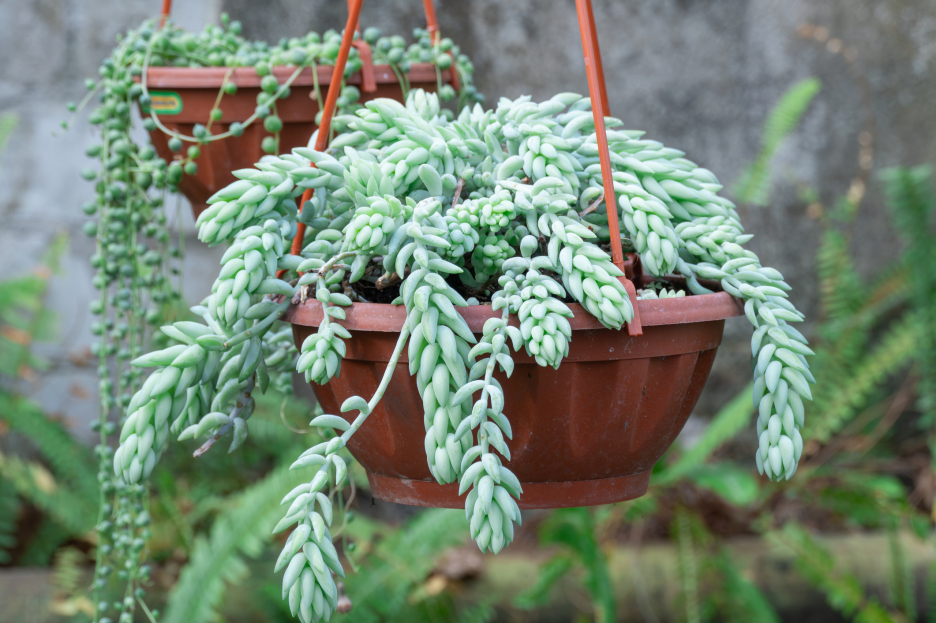
With its trailing stems of plump, blue-green leaves, Burro’s Tail, also known as Donkey’s Tail, is a standout succulent that adds texture and charm to any indoor or outdoor plant display. Native to southern Mexico and Honduras, this drought-tolerant plant is loved for its cascading habit and unique look, especially when grown in a hanging basket or on a sunny shelf.
While it's relatively easy to care for, Burro’s Tail does require a gentle touch—especially when handling, as the leaves are fragile and prone to falling off. Here’s everything you need to know to keep your Sedum morganianum healthy and thriving.
Burro’s Tail thrives in bright, indirect light, but it can also handle a few hours of direct sunlight each day. A sunny windowsill, especially one facing east or south, is an ideal spot indoors. Too little light may cause the stems to become stretched or "leggy," while too much harsh sun can cause sunburn on the leaves.
If you’re growing it outdoors during warmer months, make sure it’s in a spot with morning sun and afternoon shade to prevent scorching.
As a succulent, Burro’s Tail prefers to stay on the dry side. Water thoroughly when the soil is completely dry, allowing excess water to drain away. In the spring and summer, this might mean watering every 2–3 weeks, while in cooler months, watering can be cut back to once a month or even less.
Always err on the side of underwatering—overwatering is the most common way to harm this plant, as it can lead to root rot. Make sure the pot has good drainage and never let the plant sit in standing water.
Burro’s Tail prefers warm, dry conditions similar to its native habitat. Ideal indoor temperatures range between 65–80°F (18–27°C). It is not frost-tolerant, so if grown outdoors, bring it inside once temperatures drop below 50°F (10°C).
Humidity is not a concern for this plant. In fact, low humidity is ideal, as excess moisture can cause problems with rot.
Use a well-draining cactus or succulent mix. You can also make your own by combining potting soil with sand, perlite, or pumice to improve drainage. Avoid rich, moisture-retaining soils.
When potting or repotting, handle Burro’s Tail gently. Its leaves detach easily from the stems, so consider potting the plant by tipping the container on its side and sliding the plant out to avoid unnecessary stress. Repotting is usually only needed every few years or if the plant has outgrown its pot.
Fertilize sparingly. During the growing season (spring and summer), you can feed Burro’s Tail once a month with a diluted cactus or succulent fertilizer. Avoid feeding your Burros Tail in fall and winter when the plant is dormant.
Too much fertilizer can cause the plant to grow weak, elongated stems that are more prone to dropping leaves.
Little pruning is needed. You can snip back any overly long or damaged stems to maintain the plant’s shape or encourage branching. Trimmings can often be propagated into new plants (more on that below).
Always use clean scissors and avoid tugging at the stems to minimize leaf drop.
Burro’s Tail is very easy to propagate. Simply place healthy fallen leaves or cut stem sections on top of dry, well-draining soil. After a few days, lightly mist the surface to encourage root formation. Within a few weeks, you’ll notice tiny roots and new growth starting to form.
Propagation is best done in spring or early summer when the plant is actively growing.
Burro’s Tail is non-toxic to pets and humans, making it a safe choice for homes with curious cats, dogs, or children. However, its delicate leaves are easily knocked off, so try to keep it in a low-traffic area or out of reach.